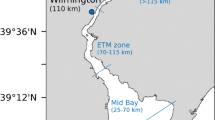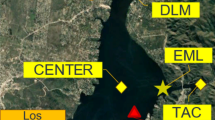Abstract
The local response of the phytoplankton community to river inflow processes was investigated with modeling and field analyses in a long and narrow, stratified reservoir in mid-summer. The river water had high concentrations of phosphorus and nitrogen (ammonium and nitrate) and temperature had large variations at diurnal scales. As a consequence of the large variation in river temperature, the level of neutral buoyancy (the depth where the river water spreads laterally in the reservoir) oscillated between the surface (overflows) during the day, and the depth of the metalimnion (interflows) during the night. The reservoir remained strongly stratified, which favoured the presence of cyanobacteria. It is shown that under these conditions, nutrient-rich river water injected during overflows into the surface layers promoted the occurrence of localized algal blooms in the zones where the overflow mixed with the quiescent water of the reservoir. A series of hydrodynamic simulations of the reservoir were conducted both with synthetic and realistic forcing to assess the importance of river temperatures and wind-driven hydrodynamics for algal blooms. The simulations confirmed that the river inflow was the main forcing mechanism generating the localized bloom.








Similar content being viewed by others
References
Ahlfeld D, Joaquin A, Tobiason J, Mas D (2003) Case study: impact of reservoir stratification on interflow travel time. J Hydraul Eng 129:966–975
Armengol J, Garcia JC, Comerma M, Romero M, Dolz J, Roura M, Han BH, Vidal A, Simek K (1999) Longitudinal processes in Canyon type reservoir: the case of Sau (N.E. Spain). In: Tundisi JG, Straskraba M (eds) Theoretical reservoir ecology and its applications. Backhuys Publishers, Leiden, pp 313–345
Barquero EJ (2001) Design, construction and assessment of automatic analyzers for environmental monitoring. PhD Dissertation, Universitat Autònoma de Barcelona, Spain (in Catalan)
Borrego CM, García-Gil LJ (1994) Separation of bacteriochlorophyll homologues from green photosynthetic sulfur bacteria by reversed-phase HPLC. Photosynth Res 41:157–163
Bournet PE, Dartus D, Tassin B, Vincon-Leite B (1999) Numerical investigation of plunging density current. J Hydr Eng-ASCE 125:584–594
Britter RE, Linden PF (1980) The motion of the front of a gravity current travelling down an incline. J Fluid Mech 99:531–543
Carmack EC (1979) Combined influence of inflow on lake temperatures on spring circulation in a riverine lake. J Phys Oceanogr 9:422–434
Carmack EC, Wiegand RC, Daley RJ, Gray CBJ, Jasper S, Pharo CH (1986) Mechanisms influencing the circulation and distribution of water mass in a medium residence-time lake Limnol. Oceanogr. 31:249–265
Chan TU, Hamilton DP, Robson BJ (2003) Modelling phytoplankton succession and biomass in a seasonal West Australian estuary. Verh Int Verein Limnol 28:1086–1088
Chung S, Gu R (1998) Two-dimensional simulations of contaminant currents in a stratified reservoir. J Hydr Eng-ASCE 124:704–711
Dallimore C, Imberger J, Ishikawa T (2001) Entrainment and turbulence in a saline underflow in Lake Ogawara. J Hydr Eng-ASCE 127:937–948
Dallimore CJ, Hodges BR, Imberger J (2003) Coupling an underflow model to a three-dimensional hydrodynamic model. J Hydr Eng-ASCE 129:748–757
Dallimore CJ, Imberger J, Hodges BR (2004) Modeling a plunging underflow. J Hydr Eng-ASCE 130:1068–1076
Ellison TH, Turner JS (1959) Turbulent entrainment in stratified flows. J Fluid Mech 6:423–448
Fernandez RL, Imberger J (2008) Time-varying underflow into a continuous stratification with bottom slope. J Hydr Eng-ASCE 134:1191–1198
Finger D, Schmid M, Wüest A (2006) Effects of upstream hydropower operation on riverine particle transport and turbidity in downstream lakes. Water Resour Res 42:W08429. doi:10.1029/2005WR004751
Fischer HB, Smith RD (1983) Observations of transports to surface waters from a plunging inflow to Lake Mead. Limnol Oceanogr 28:258–272
Fischer HB, List EJ, Koh RCY, Imberger J, Brooks NH (1979) Mixing in inland and coastal waters. Academic Press, New York, p 483
Fleenor WE, Schladow SG (2000) Mixing in the plunge zone of lake inflows. In: Proceedings of the Fifth International Symposium on Stratified Flows. Vancouver, BC
Gippel CJ (1989) The use of turbidimeters in suspended sediment research. Hydrobiologia 176:465–480. doi:10.1007/BF00026582
Gippel CJ (1995) Potential of turbidity monitoring for measuring the transport of suspended-solids in streams. Hydrol Processes 9:83–97. doi:10.1002/hyp.3360090108
Gómez-Giraldo A, Imberger J, Antenucci JP (2006) Spatial structure of the dominant basin-scale internal waves in Lake Kinneret. Limnol Oceanogr 51:229–246
Grasshoff K, Erhardt M, Kremling K (1983) Methods of seawater analysis. Verlag Chemie, Weinheim
Guerrero R, Montesinos E, Pedrós-Alió C, Esteve I, Mas J, Van Gemerden H, Hofman PA, Baker JF (1985) Phototrophic sulphur bacteria in two Spanish lakes: vertical distribution and limiting factors. Limnol Oceanogr 30:919–931
Hallworth M, Huppert H, Phillips J, Sparks S (1996) Entrainment into two-dimensional and axisymmetric turbulent gravity currents. J Fluid Mech 308:289–311
Hauenstein W, Dracos TH (1984) Investigation of plunging density currents generated by inflows in lakes. J Hydraul Res 22:157–179
Hebbert B, Imberger J, Loh I, Patterson J (1979) Collie River underflow into the Wellington Reservoir. J Hydraul Div-ASCE 105:533–545
Hillmer I, Imberger J (2007) Influence of advection on scales of ecological studies in a coastal equilibrium flow. Cont Shelf Res 27:134–153
Hipsey MR, Antenucci JP, Brookes JD, Burch MD, Regel RH, Linden L (2004) A three dimensional model of Cryptosporidium dynamics in lakes and reservoirs: a new tool for risk management. Intl J River Basin Manag 2:1–17
Hodges BR (2000) Numerical techniques in CWR-ELCOM. Technical report, Centre for Water Research, University of Western Australia, Nedlands, Western Australia, 6907. Reference WP 1422-BH
Hodges BR, Imberger J (2001) Simple curvilinear method for numerical methods of open channels. J Hydr Eng-ASCE 127:949–958
Hodges BR, Imberger J, Saggio A, Winters KB (2000) Modeling basin-scale internal waves in a stratified lake. Limnol Oceanogr 45:1603–1620
Hoyer AB, Moreno-Ostos E, Vidal J, Blanco JM, Palomino-Torres RL, Basanta A, Escot C, Rueda FJ (2009) The influence of external perturbations on the functional composition of phytoplankton in a Mediterranean reservoir. Hydrobiologia 636:49–64
Jain SC (1981) Plunging phenomena in reservoirs, In: Stefan HG (ed), Proceedings of the Symposium on Surface Water Impoundments. ASCE, New York, pp 1249–1257
Jin K-R, Hamrick JH, Tisdale T (2000) Application of three-dimensional hydrodynamic model for Lake Okeechobee. J Hydr Eng-ASCE 126:758–771
Kassem A, Imran J, Khan JA (2003) Three-dimensional modeling of negatively buoyant flow in diverging channels. J Hydr Eng-ASCE 129:936–947
Kennedy RH (1999) Reservoir design and operation: limnological implications and management opportunities. In: Tundisi JG, Straskraba M, Straskraba M (eds) Theoretical reservoir ecology and its applications. Backhuys Publishers, Leiden, pp 1–28
Kimmel BL, Lind OT, Paulson LJ (1990) Reservoir primary production. In: Thornton KW, Kimmel BL, Payne FE (eds) Reservoir limnology ecological perspectives. Wiley, NY, pp 133–193
Laval B, Imberger J, Hodges B, Stoker R (2003) Modeling circulation in lakes: spatial and temporal variations. Limnol Oceanogr 48:983–994
Marcé R, Comerma M, Garcia JC, Armengol J (2004) A neuro-fuzzy modeling tool to estimate fluvial nutrient loads in watersheds under time-varying human impact. Limnol Oceanogr Meth 2:342–355
Marcé R, Moreno-Ostos E, Armengol J (2008) The role of river inputs on the hypolimnetic chemistry of a productive reservoir: implications for management of anoxia and total phosphorus internal loading. Lake Reserv Manag 24:87–98
Morillo S, Imberger J, Antenucci J, Woods PF (2008) Influence of wind and lake morphometry on the interaction between two rivers entering a stratified lake. J Hydr Eng ASCE 134:1579–1589
Murphy I, Riley JP (1962) A modified single-solution method for determination of phosphate in natural waters. Anal Chim Acta 27:31–36
Nedoma J, Garcia JC, Comerma M, Simek K, Armengol J (2006) Extracellular phosphatases in a Mediterranean reservoir: seasonal, spatial and kinetic heterogeneity. Freshwat Biol 51:1264–1276
Ordóñez J (2010) Limnología del embalse de Sau. Relaciones del zooplacton, la clorofila y los sólidos en suspensión con el clima lumínico del agua. PhD Dissertation, Universitat Autònoma de Barcelona, Spain (in Spanish)
Pickrill RA, Irwin J (1982) Predominant headwater inflow and its control of lake-river interaction in Lake Wakatipu. New Zeal J Mar Fresh 16:201–213
Ramon M (2003) Development of an automatic analyzer for phosphate ion in surface waters. PhD Dissertation, Universitat Autònoma de Barcelona, Spain (in Catalan)
Reynolds CS (2001) Emergence in pelagic communities. Sci Mar 65:5–30
Reynolds CS, Huszar V, Kruk C, Naselli-Flores L, De Melo S (2002) Towards a functional classification of the freshwater phytoplankton. Rev J Plankton Res 24:417–428
Robson BJ, Hamilton DP (2004) Three-dimensional modelling of a Microcystis bloom event in the Swan River estuary, Western Australia. Ecol Model 174:203–222
Romero JR, Antenucci JP, Imberger J (2004) One- and three-dimensional biogeochemical simulations of two differing reservoirs. Ecol Model 174:143–160
Savage SB, Brimberg J (1975) Analysis of plunging phenomena in water reservoirs. J Hydraul Res 13:187–204
Serra T, Vidal J, Colomer J, Casamitjana X, Soler M (2007) The role of surface vertical mixing in phytoplankton distribution in a stratified reservoir. Limnol Oceanogr 52:620–634
Serra T, Borrego C, Quintana X, Calderer L, López R, Colomer J (2009) Quantification of the effect of nonphotochemical quenching on the determination of in vivo Chl a from phytoplankton along the water column of a freshwater reservoir. Photochem Photobiol 85:321–331
Simek K, Comerma M, Garcia JC, Nedoma J, Marcé R, Armengol J (2011) The effect of river water circulation on the distribution and functioning of reservoir microbial communities as determined by a relative distance approach. Ecosystems 14:1–14
Spillman CM, Imberger J, Hamilton D, Hypsey M, Romer J (2007) Modelling the effects of Po River discharge, internal nutrient cycling and hydrodynamics on biogeochemistry of the Northern Adriatic Sea. J Mar Syst 68:167–200
Stevens C, Hamblin PF, Lawrence GA, Boyce FM (1995) River-induced transport in Kootenay lake. J Environ Eng 121:830–837
Utermöhl H (1958) Zur Vervollkommnung der quantitativen Phytoplankton Methodik. Mitteilungen der Internationalen Vereinigung fu¨r Limnologie 9:1–38
Vidal J, Casamitjana X (2008) Forced resonant oscillations as response to periodic winds in a stratified reservoir. J Hydr Eng 134:416–425
Vidal J, Casamitjana X, Colomer J, Serra T (2005) The internal wave field in Sau Reservoir: observation and modeling of a third vertical mode. Limnol Oceanogr 50:1326–1333
Vidal J, Moreno-Ostos E, Escot C, Quesada R, Rueda F (2010) The effects of diel changes in circulation and mixing on the longitudinal distribution of phytoplankton in a canyon-shaped Mediterranean reservoir. Freshwat Biol 55:1945–1957
Acknowledgments
Thanks to the Centre for Water Research (CWR, University of Western Australia) and its director, Jörg Imberger, for making the Estuary and Lake Computer Model (ELCOM) available for use in this project. This work has been financially supported in part by both MICINN and the Fulbright Program through Grant #2008-0909.
Author information
Authors and Affiliations
Corresponding author
Rights and permissions
About this article
Cite this article
Vidal, J., Marcé, R., Serra, T. et al. Localized algal blooms induced by river inflows in a canyon type reservoir. Aquat Sci 74, 315–327 (2012). https://doi.org/10.1007/s00027-011-0223-6
Received:
Accepted:
Published:
Issue Date:
DOI: https://doi.org/10.1007/s00027-011-0223-6




